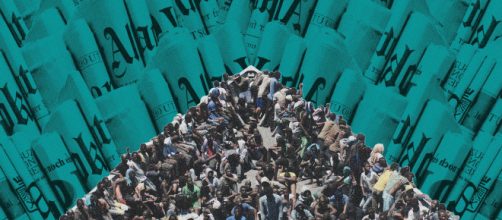Hey, this is Angelo Paura and you are about to start reading It’s not True, our weekly newsletter about misinformation and false narratives. This week - and for the next three weeks - we are going to cover the real migrant crisis, the one fueled by misinformation. I already used the metaphor of the virus to talk about misinfo: it selects the most divisive and discussed topics at a global or local level, it replicates itself and turns upside down the truth to influence readers and shape their views. This is especially true when we talk about migrants.
But, talking about migrants and migration is not simple, because we are facing a multi-crisis all over the world - from the Mediterranean Sea, where last week more that 12,000 migrants arrived on the island of Lampedusa, to the border between the U.S. and Mexico - that will shape the future of our democracies. That’s why bad actors, disinformation super-spreaders and politicians are so interested in this.
In this series we are going to tackle the problem from three different angles:
- This week we are going to delve into misleading news about migrants - used by politicians and states to change the perceptions of voters and divide communities.
- Next week we will go deep into two big conspiracy theories about migrants and migrations.
- The third week we will analyze an aspect that is often missed: How misinformation is targeting migrants, affecting their lives and pushing them through wrong decisions.
Now, enjoy the chill of the first fall weekend and dedicate five minutes to It’s not True.
For questions and ideas we are here to listen! Shoot us an email at factcheck@blastingnews.com.
Growing up in a small and affluent village in Northern Italy in the 90’s, I clearly remember my first encounter with disinformation about migrants. I remember hours of newscasts focused on the arrivals of migrants from Albania, the political propaganda of the far-right saying that it was an invasion, and a robust set of conspiracy theories to describe “them” as something different and terrible to “us.” In 1991, during the peak of the arrivals, I also remember the predominant narrative: these migrants will destroy our countries, bring violence and crime, conquer our institutions and rewind the clock of our civilization.
I saw “them” in my small town, slowly integrating into the fabric of our society. In fact, after 30 years, several studies - and also hundreds of success stories - show us the opposite: That “invasion” benefited both Italy and Europe: Albanian communities are well-integrated and produce wealth.
In the last 10 years, thanks to social media and smartphones, we have experienced a second wave of misinformation about migrants, led by far-right and populist parties. It is well-orchestrated, in the sense that (a) beyond far-right parties, now we also have foreign states - like Russia and China’s bot farms, or foreign bad actors like Steven Bannon - using misinformation to sow division within the European Union; (b) conspiracy theories that have a strong influence on people’s minds, including the Kalergi Plan, the Great Replacement and so-called racism against white people (we will go deeper into these topics next week); (c) social media, smartphones, the internet.
The same strategy we can observe in Europe is replicated in the U.S., where Donald Trump ran two entire presidential campaigns on the basis of fake news about migrants from South and Central America.
Now we are going to enter in a new era of misinformation, fueled by generative AI. Are we going to be able to distinguish between true and false? A recent research lead by Giovanni Spitale at the University of Zurich and published in Science Advances finds that people were 3% less likely to spot false tweets generated by AI than those written by humans and a project called CounterCloud shows how with $400 everyone can build an AI misinformation machine.

